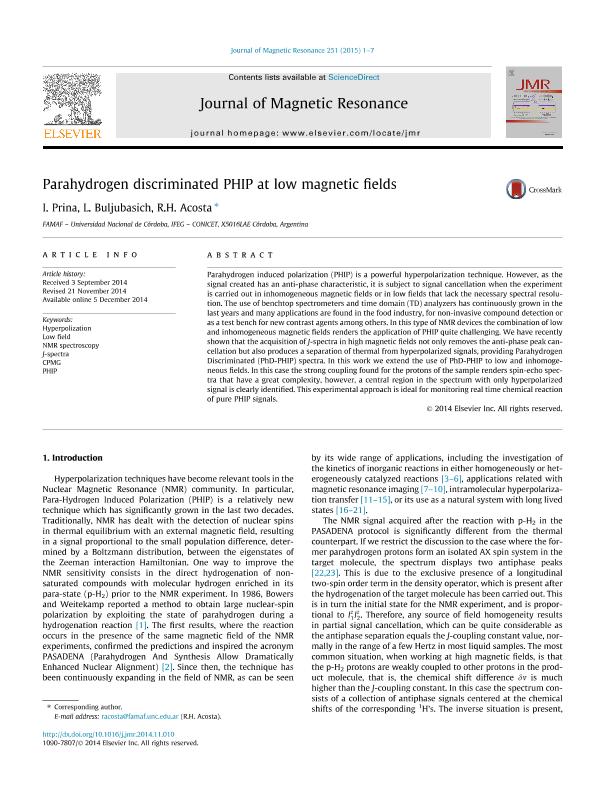Artículo
Parahydrogen discriminated PHIP at low magnetic fields
Fecha de publicación:
02/2015
Editorial:
Academic Press Inc Elsevier Science
Revista:
Journal of Magnetic Resonance
ISSN:
1090-7807
e-ISSN:
1096-0856
Idioma:
Inglés
Tipo de recurso:
Artículo publicado
Clasificación temática:
Resumen
Parahydrogen induced polarization (PHIP) is a powerful hyperpolarization technique. However, as the signal created has an anti-phase characteristic, it is subject to signal cancellation when the experiment is carried out in inhomogeneous magnetic fields or in low fields that lack the necessary spectral resolution. The use of benchtop spectrometers and time domain (TD) analyzers has continuously grown in the last years and many applications are found in the food industry, for non-invasive compound detection or as a test bench for new contrast agents among others. In this type of NMR devices the combination of low and inhomogeneous magnetic fields renders the application of PHIP quite challenging. We have recently shown that the acquisition of J-spectra in high magnetic fields not only removes the anti-phase peak cancellation but also produces a separation of thermal from hyperpolarized signals, providing Parahydrogen Discriminated (PhD-PHIP) spectra. In this work we extend the use of PhD-PHIP to low and inhomogeneous fields. In this case the strong coupling found for the protons of the sample renders spin-echo spectra that have a great complexity, however, a central region in the spectrum with only hyperpolarized signal is clearly identified. This experimental approach is ideal for monitoring real time chemical reaction of pure PHIP signals.
Palabras clave:
CPMG
,
HYPERPOLIZATION
,
J-SPECTRA
,
LOW FIELD
,
NMR SPECTROSCOPY
,
PHIP
Archivos asociados
Licencia
Identificadores
Colecciones
Articulos(IFEG)
Articulos de INST.DE FISICA ENRIQUE GAVIOLA
Articulos de INST.DE FISICA ENRIQUE GAVIOLA
Citación
Prina, Ignacio; Buljubasich Gentiletti, Lisandro; Acosta, Rodolfo Héctor; Parahydrogen discriminated PHIP at low magnetic fields; Academic Press Inc Elsevier Science; Journal of Magnetic Resonance; 251; 1; 2-2015; 1-7
Compartir
Altmétricas




